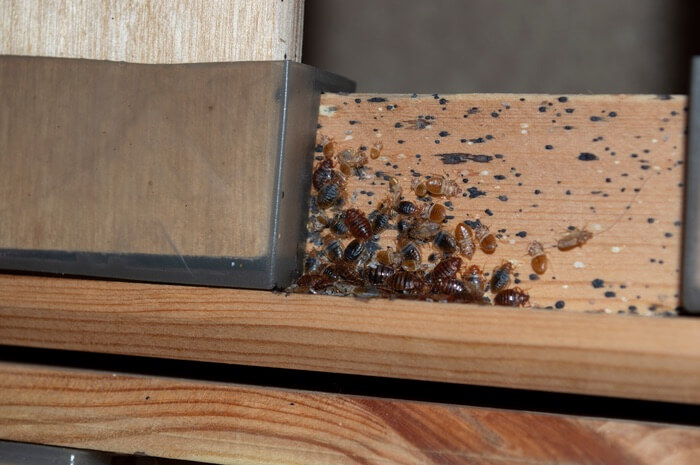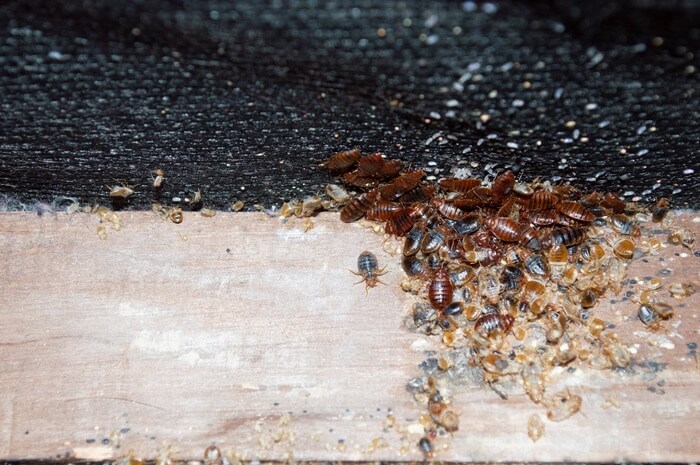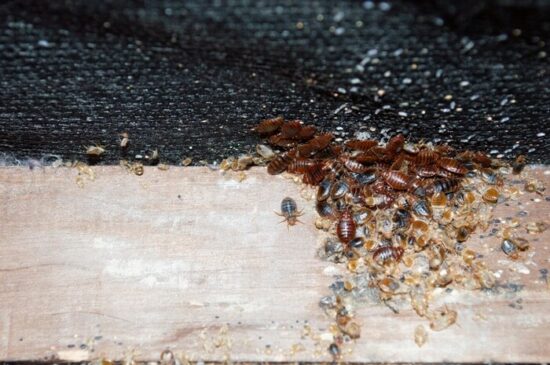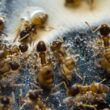Being able to identify and find bed bug nests is critical if you want to get rid of an infestation. You can’t deal with these pests one by one, you need to go to the source!
This guide will teach you about bed bug nests and provide some tips (and pictures) to help make the process easy.
Table of contents
Do Bed Bugs Have Nests?
When you find evidence of bed bugs, it’s quite natural to want to get to the source of the problem.
With something such as an ant or termite infestation, the way to solve the problem is to locate the nest and kill off the queen. However, this is not how it works when it comes to bed bugs, and this fact makes dealing with an infestation a lot trickier.
What often makes getting rid of bed bugs such a difficult and drawn-out process is the fact that bed bug nests are a bit different than you see with other pests. You’re not going to find one major spot, governed by a queen, where bed bugs are hanging out, laying eggs and growing into adults.
- Kill bed bugs and bed bug eggs
- Use spray as a spot treatment around bed frames, mattress seams/tufts/folds, and baseboards
- Kills even the toughest bed bugs
- The continuous spray Comfort Wand easily gets into hard-to-reach areas
Instead, bed bugs create what is called a harborage. A harborage is basically a protected space where the bed bugs feel safe to digest, shed, grow, eliminate waste and lay eggs. In the case of a serious infestation, there can be several of these harborages located throughout the home.
Quick Tip: Even though a harborage is not technically a nest, it can still contain a huge number of bed bugs. It’s more a “safety in numbers” kind of thing rather than a true nest. In fact, bed bugs will often release pheromones that tell other bed bugs that there is a safe-zone nearby.
Unlike other insect nests that are usually found outside of the home, a bed bug harborage is going to be as near to the food source as possible. Any small area that is safe and protected is fair game, and this includes places such as cracks in the walls, mattresses, books, wood furniture, curtains, electronics, and behind wallpaper.
We will often use the term “nest” in this guide, but just know that we’re really referring to a bed bug harborage.
What Does A Bed Bug Nest Look Like?
It’s kind of hard to describe what a bed bug nest looks like because, as discussed above, bed bugs don’t have classic nests. This can make things a lot trickier because you are not going to find one central location where all the bed bugs are congregating.
Luckily, bed bug harborages are fairly easy to recognize once you know what you’re looking for. Let’s briefly go over some of the things that you may find in a typical bed bug nest.
You will almost certainly find eggs in a bed bug nest. These eggs can range from the size of a poppy seed to as long as a small grain of rice. Depending on how far developed the eggs are, they may appear white or a creamish-tan. Female bed bugs use a glue-like substance to keep the eggs in place, so the eggs you see may look like a sticky cluster. Due to their size, you will need plenty of light and perhaps a magnifying glass to see the eggs.

Along with eggs, you will typically find juvenile bed bugs in various stages of development. Very young bed bugs will still look like eggs, but you will see two small, red dots where the eyes will be. After the eggs hatch, the bed bugs are in what is referred to as the nymph stage. These baby bed bugs pretty much look like their adult counterparts, but they are much smaller. A nymph will need to grow and shed five times before it is considered to be an adult, so a typical harborage will have nymphs of many different sizes.
Of course, every bed bug nest will also have lots of adults. You will be able to tell which ones are the adults because they are very flat and are about the size and color of an apple seed. You also may notice wing pads on the backs of adult bed bugs.
Some other items you are certain to find in a bed bug harborage include previously shed exoskeletons, black spots of fecal matter and maybe even dead bed bugs.
Quick Tip: Depending on the level of infestation you have, a nest may look like a collection of a few eggs and adults, or it may be a larger area that’s a mixture of accumulated debris and living insects.
How To Find Bed Bug Nests
When you are looking for the source of your bed bug infestation, you need to remember that you are not going to find one large nest. Instead, you are going to be looking for the kind of small harborages that we discussed earlier. Some of these harborages may only have a few bugs in them, while others may contain hundreds of bed bugs and their debris.
It’s very important to find all of the places where bed bugs are hiding if you want to eliminate the whole problem. If you have a serious infestation, it’s usually a good idea to get some assistance from a pest control specialist. They will have experience with a wide range of infestations and have a better idea of where to look and what to look for.
Interestingly enough, pest control specialists are starting to use dogs to locate bed bug nests in the home. With a keen sense of smell and very specialized training, these dogs are able to detect bed bug-ridden areas and hone in on where they are hiding. In fact, dogs have around 45 times more smell receptors than humans, so they are able to sniff out and locate bed bug nests in places that we would never even think to explore. This is especially important if the bugs are behind walls, under wallpaper or inside electrical outlets.

If you’re one of the many homeowners who doesn’t want to hire a professional and prefers to get their hands dirty, there are some things you can do to find bed bug nests on your own. No matter which route you choose, it’s going to require lots of time and patience. Nests can be found just about anywhere, so you’ll need to literally check just about every nook and cranny.
- Kill bed bugs and bed bug eggs
- Use spray as a spot treatment around bed frames, mattress seams/tufts/folds, and baseboards
- Kills even the toughest bed bugs
- The continuous spray Comfort Wand easily gets into hard-to-reach areas
One great place to start looking for a congregation of bed bugs is in and around the bed. Using a strong light source and a magnifying glass, carefully inspect pillows, mattresses, the box spring, the bed frame and all blankets or comforters. During this inspection you are going to want to look for eggs, exoskeletons, droppings and bed bugs in various stages of development.
Quick Tip: When we say to carefully inspect an area, we mean that you will pretty much need to check every single fold, crack and crevice. Look in the seams of the mattress, pull the mattress from the bed to inspect the frame and thoroughly inspect the box spring. In other words, don’t let a single inch go uninspected.
To really get into those small spaces, you can poke around with something like a putty knife, the edge of a credit card or a small spatula. If you find something, you will want to examine your find to make a positive identification. You can put your findings into a small jar that contains some alcohol-based hand sanitizer.
Even though most bed bugs remain very close to where you sleep, there are lots of other places in your home where you can find them. As carefully as you check near your sleeping area, you’ll want to also search areas like window frames, doors and door hinges, under loose pieces of wallpaper, under rugs, smoke detectors, window treatments and inside books. Even framed pictures on the wall are fair game to these insidious insects.
In other words, you’ll need to leave no stone unturned when it comes to locating all the places in your home where bed bugs may be hiding.
Luckily, there are some places in your home that usually don’t end up with bed bug nests. These rooms include the bathroom, garages, kitchens and unfinished basements.
When Do Bed Bugs Usually Leave Their Nests?
Bed bugs like to stay where it is dark, safe and dry. And for the most part, they will stay in their nesting area. Many people incorrectly think that bed bugs only come out at night, but this is not quite true.
One of the main reasons why a bed bug will leave the nest is if they are in search of a meal. Because they feed on the blood of sleeping humans, it stands to reason that they would appear to be active mostly at night. However, bed bugs will take advantage of an opportunity to feed no matter the time of day.
Bed bugs don’t feed every night (they can live for a while without food), so they are usually to be found hanging around their nesting area. After a good feed, it takes an average bed bug several days to digest their meal, and they will not usually feed again until they are hungry.
Another reason that a bed bug will leave the nest is if it’s a female that has already mated several times. She may leave the area to lay her eggs in a new spot, or she may go in search of another harborage.
Quick Tip: If a bed bug nest is getting to be a bit too crowded, some of these insects may decide to venture out and find another place to rest.
Why Is Finding Bed Bug Nests So Important?
Going through your house with a fine-tooth comb to find bed bug nests may seem like more hassle than it’s worth. But this thorough search will not only be worth it in the long run, but it is absolutely critical if you want to get rid of your bed bug problem once and for all.
While it’s true that you, as the homeowner, may want to try to deal with your bed bug issue on your own, you should make sure you’re comfortable before giving it a shot. In our experience, dealing with a serious infestation is not something that inexperienced homeowners should attempt.
As we’ve already learned, bed bugs can be found in just about every room in your home. If you don’t find and destroy every bed bug nest, then the bugs are just going to keep multiplying, and you will never have a bed bug-free home.
Don’t forget that bed bugs spread very fast, and if you don’t get rid of every single egg, nymph and adult, then you run the risk of bringing unwanted visitors to your neighbors, friends and family. If they end up with an infestation, the chances are very high that your home will be re-infested.
If you need some extra help, a pest control specialist has the tools, knowledge and experience to help you find all of the places where bed bugs may be hiding. They will also be able to come up with an eradication plan that will fit your budget and situation.
Closing Thoughts
Now that you’ve learned how to find bed bug nests and have some sample pictures to review, there’s nothing stopping you from going out and finding these critters on your own.
If you’re having some trouble identifying a nest and want some feedback just let us know! We’re always happy to help.



